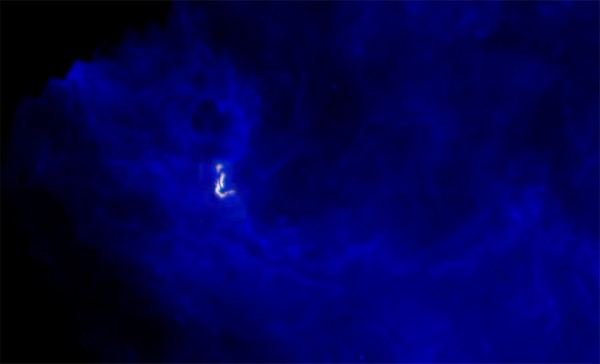Scientists Witness Quadruple Star System Formation for the First Time Ever
| Ana Verayo | | Feb 12, 2015 08:19 AM EST |
(Photo : Bill Saxton/NRAO/AUI/NSF) The B5 complex (red and green; radio images) seen within its neighborhood, embedded in dust (blue) as seen with ESA's Herschel Space Observatory, in infrared light.
Astronomers were quite excited when they recently observed a multiple star system and witnessed their formation during the earliest stages for the first time ever.
The most common type of interstellar systems found in the Milky Way Galaxy are multiple star systems that have two or more stars orbiting each other. This formation has remained an enigma for scientists until now.
Like Us on Facebook
A team of scientists used the Very Large Array; the Green Bank Telescope and the James Clerk Maxwell Telescope in Hawaii to unravel the mystery as they studied a dense core of gas named Barnard 5. This object is located in a region where young stars constantly form. It's in the constellation Perseus some 800 light years away from Earth.
When researchers were mapping radio emissions emitted by methane molecules in the vicinity of the proto star, they detected some fragmented filaments consisting of gas condensing into a four star formation.
The gases from the condensations will collapse from its own gravitational forces and will form new stars for the next 40,000 years, a relatively short time in astronomical terms. The stars are separated from each other by distances ranging from 3,000 to 11,000 astronomical units. One astronomical unit is equal to 150 million kilometers, which is also the exact distance of the Earth to the Sun.
Using high resolution observations of Barnard 5, the team could visually take note of the activity inside the star system.
According to study lead author Jaime Pineda from the Max Planck Institute for Extraterrestrial Physics, star systems with more than three stars easily become unstable, meaning a four star system won't last very long. This particular formation will at least form a binary star system.
The authors believe these stars will eventually form a mass between one tenth and one third of the Sun. This study was published in the journal, Nature.
TagsScientists Witness Quadruple Star System Formation for the First Time Ever, barnard 5, birth of a multiple star system, first stage of creation multiple star system, tatooine star system
©2015 Chinatopix All rights reserved. Do not reproduce without permission
EDITOR'S PICKS
-

Did the Trump administration just announce plans for a trade war with ‘hostile’ China and Russia?
-

US Senate passes Taiwan travel bill slammed by China
-

As Yan Sihong’s family grieves, here are other Chinese students who went missing abroad. Some have never been found
-

Beijing blasts Western critics who ‘smear China’ with the term sharp power
-

China Envoy Seeks to Defuse Tensions With U.S. as a Trade War Brews
-

Singapore's Deputy PM Provides Bitcoin Vote of Confidence Amid China's Blanket Bans
-

China warns investors over risks in overseas virtual currency trading
-

Chinese government most trustworthy: survey
-

Kashima Antlers On Course For Back-To-Back Titles
MOST POPULAR
LATEST NEWS
Zhou Yongkang: China's Former Security Chief Sentenced to Life in Prison

China's former Chief of the Ministry of Public Security, Zhou Yongkang, has been given a life sentence after he was found guilty of abusing his office, bribery and deliberately ... Full Article
TRENDING STORY

China Pork Prices Expected to Stabilize As The Supplies Recover

Elephone P9000 Smartphone is now on Sale on Amazon India

There's a Big Chance Cliffhangers Won't Still Be Resolved When Grey's Anatomy Season 13 Returns

Supreme Court Ruled on Samsung vs Apple Dispute for Patent Infringement

Microsoft Surface Pro 5 Rumors and Release Date: What is the Latest?










